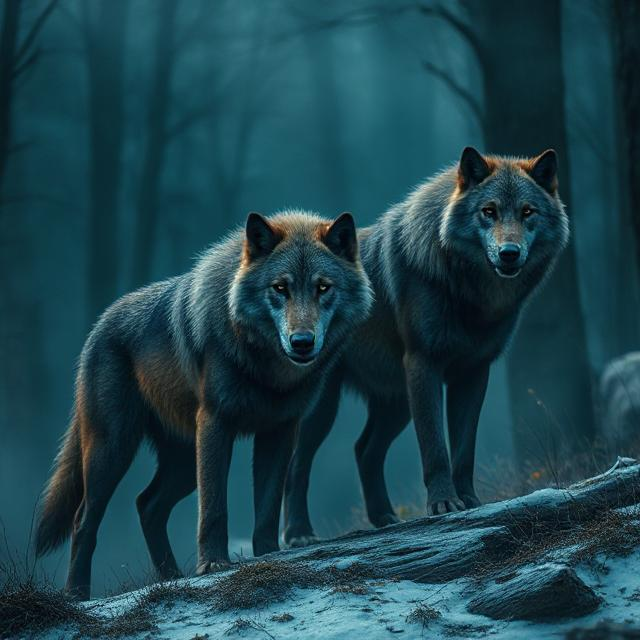Introduction
The dire wolf (Aenocyon dirus) is one of the most iconic prehistoric predators, often depicted in popular culture as a massive, savage beast. But how much of this image is based on fact, and how much is myth? This article explores the biology, behavior, and legacy of the dire wolf, separating reality from fiction.
What Were Dire Wolves?
Dire wolves were large canines that roamed North and South America during the Late Pleistocene epoch (125,000–9,500 years ago). They coexisted with saber-toothed cats, mammoths, and early humans before going extinct.
Key Features:
✔ Size & Build – Larger than modern gray wolves, weighing 130–150 lbs (compared to 80–100 lbs for gray wolves).
✔ Powerful Jaws – Stronger bite force than today’s wolves, adapted for crushing bones.
✔ Social Hunters – Likely lived and hunted in packs, similar to modern wolves.
Dire Wolves vs. Gray Wolves: Key Differences
| Feature | Dire Wolf | Gray Wolf |
|---|---|---|
| Time Period | Pleistocene (extinct) | Still exists today |
| Size | Bulkier, heavier | Leaner, more agile |
| Bite Force | Stronger (for crushing prey) | Adapted for running & endurance |
| Habitat | Forests, grasslands | Varied (tundras, forests, mountains) |
Why Did Dire Wolves Go Extinct?
Several theories explain their disappearance:
- Climate Change – Shifting ecosystems reduced their prey.
- Competition with Gray Wolves – More adaptable wolves outcompeted them.
- Human Hunting – Early humans may have contributed to their decline.

Dire Wolves in Pop Culture
Thanks to Game of Thrones, dire wolves became legendary. However, the show exaggerated their size—real dire wolves were not as large as horses but still formidable.
Appearances in Media:
- Game of Thrones (Stark family’s dire wolves)
- The Walking Dead (as zombie wolves)
- Prehistoric documentaries (Prehistoric Planet, Monsters Resurrected)
Colossal Biosciences: De-Extinction and the Future of Genetic Engineering
Introduction
Colossal Biosciences is a groundbreaking biotechnology company on a mission to bring extinct species back to life using advanced genetic engineering. Founded in 2021 by Harvard geneticist George Church and entrepreneur Ben Lamm, Colossal aims to leverage CRISPR gene-editing technology to resurrect long-lost species like the woolly mammoth, Tasmanian tiger, and dodo bird—while also advancing conservation efforts for endangered animals.
The Science Behind De-Extinction
Colossal’s approach combines CRISPR gene editing, stem cell technology, and artificial wombs to recreate species that vanished centuries or millennia ago.
Key Projects:
- Woolly Mammoth Revival
- Goal: Create a cold-resistant “mammoth-elephant hybrid” to restore Arctic grasslands.
- Progress: Editing Asian elephant DNA with mammoth traits (e.g., shaggy hair, fat storage).
- Tasmanian Tiger (Thylacine) Restoration
- Goal: Reintroduce the extinct marsupial predator to Tasmania.
- Progress: Sequencing thylacine DNA from preserved specimens.
- Dodo Bird Resurrection
- Goal: Bring back the iconic flightless bird using pigeon genomes.
- Progress: Genome sequencing completed in 2024.
Why Bring Back Extinct Species?
Colossal’s work isn’t just about scientific curiosity—it has real-world ecological benefits:
✔ Restoring Ecosystems (e.g., mammoths could prevent permafrost thawing).
✔ Advancing Genetic Tools for endangered species conservation.
✔ Medical Breakthroughs (studying ancient DNA could improve human health).
Challenges & Controversies
While the idea is exciting, Colossal faces ethical and technical hurdles:
❌ Ethical Concerns: Should humans play “creator” with extinct species?
❌ Ecological Risks: How will revived species impact modern ecosystems?
❌ Technical Barriers: Artificial womb technology is still experimental.
Investors & Collaborations
Colossal has attracted $225+ million in funding from high-profile backers, including:
- Peter Thiel’s Breakout Ventures
- Thomas Tull (former Legendary Pictures CEO)
- Paris Hilton (celebrity investor)
The company also partners with Harvard Medical School, MIT, and conservation groups.
What’s Next for Colossal?
🔬 2025-2030 Goals:
- First mammoth-elephant hybrid calves in controlled environments.
- Tasmanian tiger embryo development in lab settings.
- Expansion into de-extinction of other lost species.
Conclusion: A New Era of Genetic Engineering?
Colossal Biosciences sits at the intersection of science, ethics, and futurism. While de-extinction remains controversial, its research could revolutionize conservation, climate science, and biotechnology.
The Woolly Mammoth: Colossal Biosciences’ Quest to Resurrect an Ice Age Giant

Introduction
The woolly mammoth (Mammuthus primigenius), an iconic Ice Age behemoth, roamed the Earth for over 100,000 years before vanishing ~4,000 years ago—around the time the Great Pyramids were built. Now, Colossal Biosciences, a cutting-edge biotech company, is leading a daring mission to bring this extinct giant back to life using CRISPR gene-editing technology.
Woolly Mammoth 101: Key Facts
Physical Traits
✔ Size: Up to 11 feet tall, weighed 6 tons (like a modern African elephant).
✔ Adaptations:
- Thick fur (up to 3 feet long) and fat layers for Arctic survival.
- Curved tusks (up to 15 feet) for digging snow and fighting.
✔ Lifespan: ~60 years (similar to elephants).
Habitat & Extinction
- Roamed: Arctic tundras of North America, Europe, and Asia.
- Died out due to climate change + human hunting.
- Last survivors: Isolated populations on Wrangel Island (Russia) until ~1650 BCE.
Colossal’s De-Extinction Plan
The Science: How to Resurrect a Mammoth?
- Gene Editing: Insert cold-resistant mammoth genes (e.g., hair growth, fat storage) into Asian elephant DNA.
- Stem Cells: Create mammoth-elephant hybrid embryos in labs.
- Artificial Wombs: Grow embryos in artificial environments (since elephants’ 22-month gestation is risky).
Progress So Far (2024 Update)
✅ Mammoth genome fully sequenced (thanks to frozen Siberian specimens).
✅ First elephant stem cells created (a major hurdle cleared in March 2024).
✅ Goal: First mammoth-elephant calves by 2028.
Why Bring Back the Woolly Mammoth?
Colossal argues this isn’t just a Jurassic Park stunt—it could help the planet:
🌍 Fight Climate Change:
- Herds could restore Arctic grasslands, preventing permafrost thaw (which releases greenhouse gases).
🐘 Save Elephants: - Hybrids could share habitats with endangered Asian elephants.
🔬 Medical Breakthroughs: - Research could improve organ preservation and frostbite treatments.
Controversies & Challenges
Ethical Debates
❓ “Playing God”: Should humans revive extinct species?
❓ Ecological Risks: Could hybrids disrupt modern ecosystems?
❓ Animal Welfare: Is it fair to create an animal without a herd or natural habitat?
Technical Hurdles
- Artificial wombs for large mammals are still experimental.
- Hybrid health risks (e.g., immune system compatibility).
Mammoths in Pop Culture
From Ice Age movies to Shin Godzilla’s mammoth-like tail, these creatures captivate us. Fun fact:
- Frozen mammoths are so well-preserved that some still have liquid blood and stomach contents!
What’s Next?
- 2025-2026: Colossal plans to implant embryos in surrogate elephants or artificial wombs.
- 2030s: Potential “Pleistocene Park” in Siberia to test ecological impact.
Conclusion: A Step Toward the Future—or the Past?
Colossal’s woolly mammoth project pushes the boundaries of science, ethics, and conservation. Whether it succeeds or fails, it forces us to ask:
“If we can bring back extinct species, should we?”









Leave a Reply